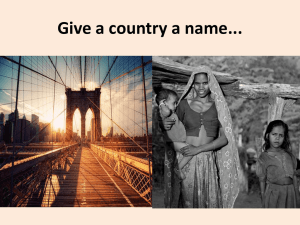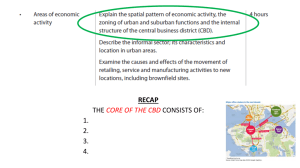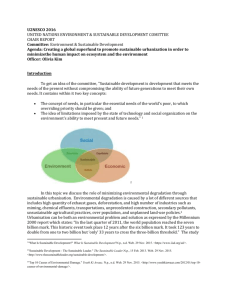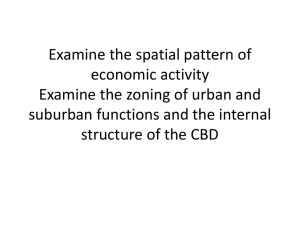URBAN ENVIRONMENTS
advertisement
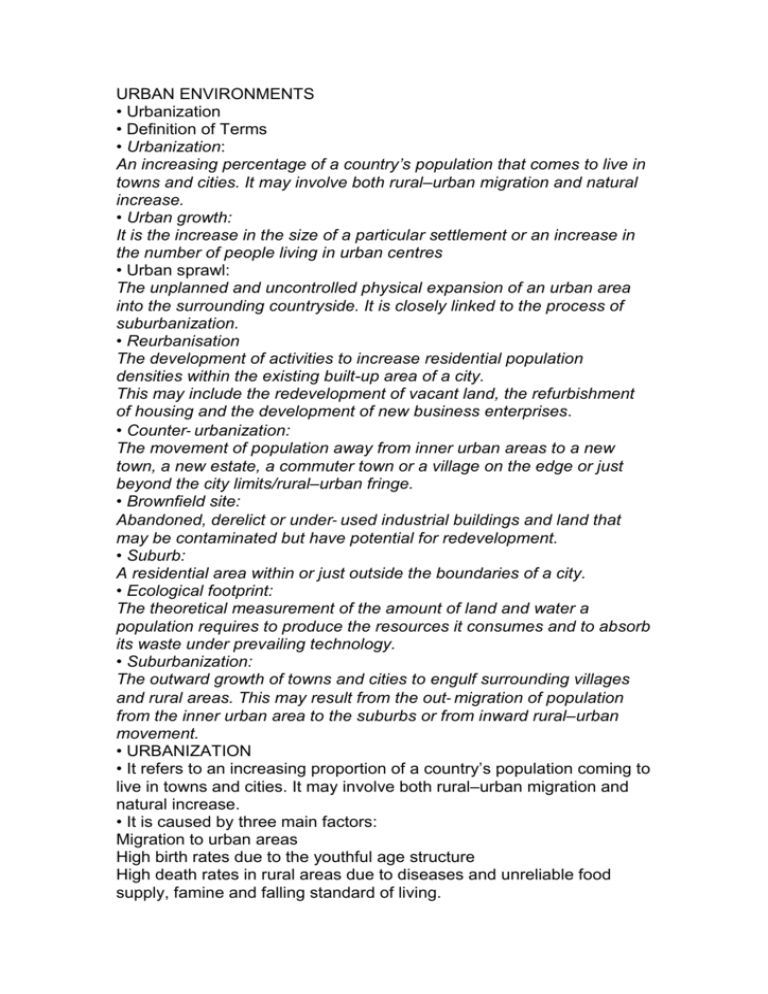
URBAN ENVIRONMENTS • Urbanization • Definition of Terms • Urbanization: An increasing percentage of a country’s population that comes to live in towns and cities. It may involve both rural–urban migration and natural increase. • Urban growth: It is the increase in the size of a particular settlement or an increase in the number of people living in urban centres • Urban sprawl: The unplanned and uncontrolled physical expansion of an urban area into the surrounding countryside. It is closely linked to the process of suburbanization. • Reurbanisation The development of activities to increase residential population densities within the existing built-up area of a city. This may include the redevelopment of vacant land, the refurbishment of housing and the development of new business enterprises. • Counter‑ urbanization: The movement of population away from inner urban areas to a new town, a new estate, a commuter town or a village on the edge or just beyond the city limits/rural–urban fringe. • Brownfield site: Abandoned, derelict or under‑ used industrial buildings and land that may be contaminated but have potential for redevelopment. • Suburb: A residential area within or just outside the boundaries of a city. • Ecological footprint: The theoretical measurement of the amount of land and water a population requires to produce the resources it consumes and to absorb its waste under prevailing technology. • Suburbanization: The outward growth of towns and cities to engulf surrounding villages and rural areas. This may result from the out‑ migration of population from the inner urban area to the suburbs or from inward rural–urban movement. • URBANIZATION • It refers to an increasing proportion of a country’s population coming to live in towns and cities. It may involve both rural–urban migration and natural increase. • It is caused by three main factors: Migration to urban areas High birth rates due to the youthful age structure High death rates in rural areas due to diseases and unreliable food supply, famine and falling standard of living. • PROCESSES OF URBANIZATION IN MEDCS • Urbanization in MEDCs has slowed down in the past few years. This is partly due to improved living conditions in rural areas, the introduction of efficient transport services and the increase in car ownership. • This has led to Urban Decay, a process whereby urban areas experience dereliction, lack of demand for inner city lands, graffiti in public places, etc. The processes affecting urban Environments in MEDCs are categorised into three: Centripetal (Inward)movements which includes: Rural-urban migration, gentrification reurbanisation(urban renewal) Centrifugal (Outward)movement which includes: Suburbanisation Counterurbanisation Urban sprawl Natural change • A. Centripetal movement Rural-urban migration: • It is the movement of people from rural areas to urban areas. It is caused by urban ‘pull’ and rural ‘push’ factors. • Urban ‘pull’ factors that attracts people from villages to cities. They include better housing, improved sanitation, job prospects, bright light syndrome etc in urban areas. • Rural ‘push’ are the difficulties people face in rural areas which compels them to move to the city. They include poor housing, poor sanitation, decline in farming, lack of educational opportunities, lack of jobs, poverty, and the generally poor level of infrastructural dev’t Gentrification • It is the process whereby middle class people move away into inner cities to buy derelict building and redevelop them into high class residential areas. • It also has an economic dimension, in which the house under dereliction is renovated to generate economic activity in the area. • It may lead to the social displacement of poor people, as the gentrified area becomes too expensive for the poor to be able to afford. • Young, married professionals begin to move to such areas thereby changing the population structure. • E.gs in New York – Greenwich Village and Brooklyn Heights. In London – Fulham and Chelsea. Reurbanisation(urban renewal) • It is the process of revitalizing urban areas and a mov’t of people from the outskirts of cities into these places. • It may involve government policies that are meant to improve the living conditions in such places, which result the injection of capital to revitalize the dilapidated area. • It includes the process of gentrification. • Urban renewal refers to the rehabilitation of city areas that have fallen into decline. • E.g. London Dockland Dev’t Corporation (LDDC) Read the New Wider World; Manhattan in New York • B. Centrifugal Movement Suburbanisation • It is the outward movement of people, industries shops from inner cities to live in areas outside the city • It is the opposite of gentrification • It occurred mainly in the US, UK and Australia around the early 20th century. • It was made possible by an improvement in transport network – electric tramways and public buses • It was also possible due to a decline in the price of farmlands, coupled with rising wages and high standards of living, necessitating private housing . Counterurbanisation • The movement of population away from inner urban areas to a new town, a new estate, a commuter town or a village on the edge or just beyond the city limits/rural–urban fringe. • It is also referred to as deurbanisation. • Reasons for counterurbanisation include; High prices of land in urban areas Congestion Pollution High crime rate Lack of community spiritedness Declining services Urban sprawl • The unplanned and uncontrolled physical expansion of an urban area into the surrounding countryside. It is closely linked to the process of suburbanization. • People living in sprawl neighborhoods drive daily to the CBD to work. • Dev’t such as shopping malls, fast food chains, and housing subdivisions are typical of sprawl environments. • They are characterized by low-density housing, large lawns, wide streets and landscaping. • E.g many large cities like London, New York, Tokyo are all characterized by urban sprawl. • C. Natural change • It refers to the process whereby urban areas expand to accommodate each other thereby, resulting in the creation of large metropolis called conurbation. • It involves urban consolidation – a process whereby the density of residential houses in urban areas are increased. • Urban consolidation is an alternative to urban sprawl. It has a number of advantages: services such as water and electricity are easier to provide in high density areas This can be achieved in two ways: • Buying disused buildings in the inner-city and replacing modern low density houses with modern high-rise, high density housing • Emergence of Urban Villages ( a residential district in a city that accommodates people with common cultural, social and economic characteristics. Eg Chinatown, Little India and Arab Quarters in Singapore. Others are on the basis of economic standing in society e.g East Legon, Trassaco Valley Estate in Accra. Beverly Hills in Los Angeles Some can be defined on the basis of ethnicity –eg. Dansoman, Kwashieman, Nungua all in Accra. Greenwich Village in New York, and Notting Hill in London. • Urban Villages have evolved due to the following factors: Location of markets or shops in certain place e.g Accra Mall Price of housing e.g expensive housing attracts high class residents to live in an elite environment Historical focal points. • Urban villages can lead to social exclusion i.e. a process whereby rich residents of a community become very concerned about their security such that their freedom of mov’t and that of their family members become restricted. • They tend to have security systems, walled estates etc and hardly talk to their neighbors. • MEGACITIES • Megacities are cities with population of over 10million people. • It occurs as a result of three main process: Economic growth, as a result of industrialization leading to an increase in demand for labour in mines and manufacturing sectors. Natural increase due to the youthful nature of urban population resulting in high birth rates Rural Urban Migration, especially in LEDCs • The last two causes are common in LEDCs • Large populations results in a increase in the number of people living in towns and cities. • In 2008, the UN claimed that 74% of the world’s population lived in towns and cities in MEDCs and 45% in LEDCs • In 1900, the only mega cities in the world were London and Paris. • Today, the number of megacities have increased with Tokyo having about 35m people by 2000. • Whilst urbanization is slowing down in MEDCs (rate of 1.5% pa) it is rapidly increasing in LEDCs, esp China at a rate of 4-5% p.a • List of world’s top 20 cities • In 2005, mega-cities accounted for about 9.3 per cent of the world’s urban population. • By 2017, other mega cities will include Mumbai, Mexico City, Sao Paulo, New York, Jakarta, Delhi, and Lagos. • Urbanization comes with environmental (pollution) and social problems (crime and dev’t of slums). • But it is also important for wealth generation – about 80% of economic output is generated from urban areas in MEDCs. • General trend in growth of mega cities • The largest cities are in South-East Asia and Latin America. • The fastest growing cities are in S.E. Asia mostly due to migration • The rate of grow of cities in MEDCs slowed in the 2nd half of 20th Cent. But picked up again due to migration • In China, most large cities are along the coastal areas. • Read Integrated Approach page 419 for details. • URBAN LAND-USE IN MEDCS • The location of residential areas in MEDCS in relation to wealth of residents can be explained using urban land-use models. • A model is an idea or a theory, which might not exist, but helps to explain reality. • It has been suggested that urban areas developed with recognizable shapes and patterns. • Two of such earliest land use models are: Burgess Hoyt • 1. Burgess – Concentric model • Burgess developed the concentric model • Studies Chicago in the United States • Claimed that towns and cities have Central Business District(CBD) in the center • Towns grew in a concentric pattern • Circles were based on: • Age of houses • Wealth of occupants Buildings become newer and the occupants more wealthier with distance from the CBD – 2. Hoyt – Sector model • He stressed the importance of transport routes in urban development. • He suggested that urban areas developed in sectors alongside the main transport route in and out of the city. • Acknowledged that the center of the city is the CBD • That low-cost housing and new industries developed in the same sector • The bid rent theory is a theory that refers to how the price and demand for land changes as the distance from the Central Business District (CBD) increases. • Basic assumption of the model is that the highest bidder gets the land and is expected to obtain maximum profit from the land. • This is based upon the idea that because businesses wish to maximize their profitability, they are willing to pay more money for land close to the CBD and less for land further away • 4. The Bid-Rent Curve • Away from the CBD land becomes less expensive for commercial activities –shown by steep angle of the curve (A-A). • Industry prefers land that is less attractive for commercial activities – shown by (B-B) • Residential Land (C-C) is found further away from the CBD where land values decrease. • The model therefore explains why population density is high near the city center (with low income earners living in low class residential areas) and why wealthy people live near the city boundary and commute to the city. Secondary land value peaks • On the basis of Bid-rent theory, ‘ the more accessible the site, the higher its land value’. • Rents will therefore be highest along main routes out of the city center and outer ring roads. • Where two of these roads intersect, a secondary PLVI develops. Such an area is likely to be a small shopping mall (e.g Accra Mall) or and industrial area. • THE FAMILY LIFE CYCLE • Housing choice or land use patterns can be influenced by the family life cycle. • It simply refers to the differences in location of people as their age, status and income in society begins to change. • Family Life Cycle - Diagram • The role of ethnicity in urban land-use • In many cities there are clearly defined ethnic or racial areas. • Examples include Harlem in New York, Watts in Los Angeles, China Town in New York. • This may be due to the need to maintain a cultural identity (positive segregation). • It could also be the result of social seclusion, where a minority group of people are excluded due to their inability to afford housing in a more affluent suburb (negative segregation). • THE CYCLE OF POVERTY AND DEPRIVATION74 • This is a concept that is related to the problems facings inner cities in urban areas. • It involves a continuous process of how poverty is transmitted from one generation to another and what makes it difficult to escape from such poverty. • Certain jobs offer low incomes, which results in low standards of living, including poor housing in a poor environment or neighborhood. • The poor environment may produce strains and stresses in the household. • This may also result in poor health amongst the household members, leading to poor academic attainment in school esp. amongst children. • Poor academic attainment could negatively affect the prospects of the younger members of the family. • The school and neighborhood may lack resources and people with skills who are needed to improve the conditions. The end result is a cycle of Poverty as shown below. • Cycle of poverty or deprivation • Indicators of Deprivation • Economic indicators Access to employment Levels of income of families • Social indicators Crime Levels of health and access to health care Proportion of lone-parent families • Physical indicators Quality of housing Level of pollution Incidence of crime Vandalism, graffiti • Environmental indicators Noise pollution Derelict land • Political indicators Opportunity to vote Opportunity to participate in community organization • Housing indicators Lacking one of more basic amenities Overcrowding No central heating • Slums and squatter settlements • In 2001, the number of slum dwellers world-wide was 924million people ( representing about 32% of world population and 78.2% of urban population in LEDCs. • It is easily to locate slums in urban areas characterized steep slopes, floodplains, edge of town locations, or areas close to industrial complexes. • Many problems face slum dwellers. Eg. Overcrowding, unemployment, housing stress etc • Rio de Janeiro • Problem facing slum dwellers Many problems face slum dwellers, including: • Overcrowding, • Unemployment, • Housing stress etc. • Insecurity of land tenure, • Lack of basic services (water and electricity), • Rising crime rate, • High concentration of poverty, social and economic deprivation. • Usefulness of slum dwellings • they serve as the first stop point for immigrants who do not have money to rent decent accommodation • They serve as place of residence of low income earners • They are the base upon which informal entrepreneurs are able to operate. • The Central Business District(CBD) Definition: • The CBD is the core of a city’s business and commercial activities and it is regarded as the centre for retailing, office location and service activities (Waugh, 2009:426). • The principal commercial streets and main public building are mostly located in the CBD. • It is the location with the highest land values Characteristics of the CBD: • Multi-storey dev’t – due to high land values • Concentration of retailing – it attracts shops with high range and threshold x’tics. • Public transport is concentrated – convergence of bus/rail routes • Vertical zoning is apparent - shops occupy ground floor and offices top floors • High day time population and low night population • Functional segregation- different type of land use occupy different part • It changes with time • Traffic restrictions are greatest there. • Central District, Macao • Shanghai, China • Tokyo, Japan • Singapore • Houston, Texas • Factors affecting CBD Decline • Poor and ageing nature of infrastructure • Increase in private car ownership • Investors attracted to out-of-town locations • Cost of dev’t and keeping the CBD • Congestion and its associated problems • Planning policies by city authorities • Companies finding edge of city locations attractive. • Informal Sector: • Informal Sector Employment is paid work on a casual basis. Jobs are irregular, and workers are often self-employed without earning pensions and without paying taxes. • This sort of employment is common in the urban areas of developing countries; for example, in Mexico City. • It may involve service jobs of the lower industrial sector—cleaning shoes or selling bottled water—as well as craft industries. • Informal employment also includes illegal activities such as theft, prostitution, and selling drugs. Characteristics • They are self employed • Less capital required • Labour intensive • Low quality standard goods • No gov’t assistance • Not legal • Irregular working hours • Model of land use in LEDCs • Causes of rapid urbanisation in LEDCs Rural Push factors: Urban pull factors Read page 80-82 of New Wider World • Case study of Shanty towns • 1. Rio de Janeiro in Brazil New Wider World -86-88 • 2. Kolkata in India (NWW, 84-89) • 3. Cairo, Egypt • Effort made by governments of these cities to solve problems facing shanty towns or slum dwellings • Read Integrated Approach: Pages ?? • Case Study of successful housing scheme to solve problem of slums in cities • Singapore: Housing success story • Urban Microclimates • Distribute photocopies • Environmental and social stress in Cities - LEDCs This simply refers to the problems resulting from Rapid Urban Growth (In LEDCs) • Housing shortage • Poor access to services – water and electricity • Traffic congestion and transport • Pollution • Unemployment and underemployment • High crime rate • Poor access to education and health facilities

